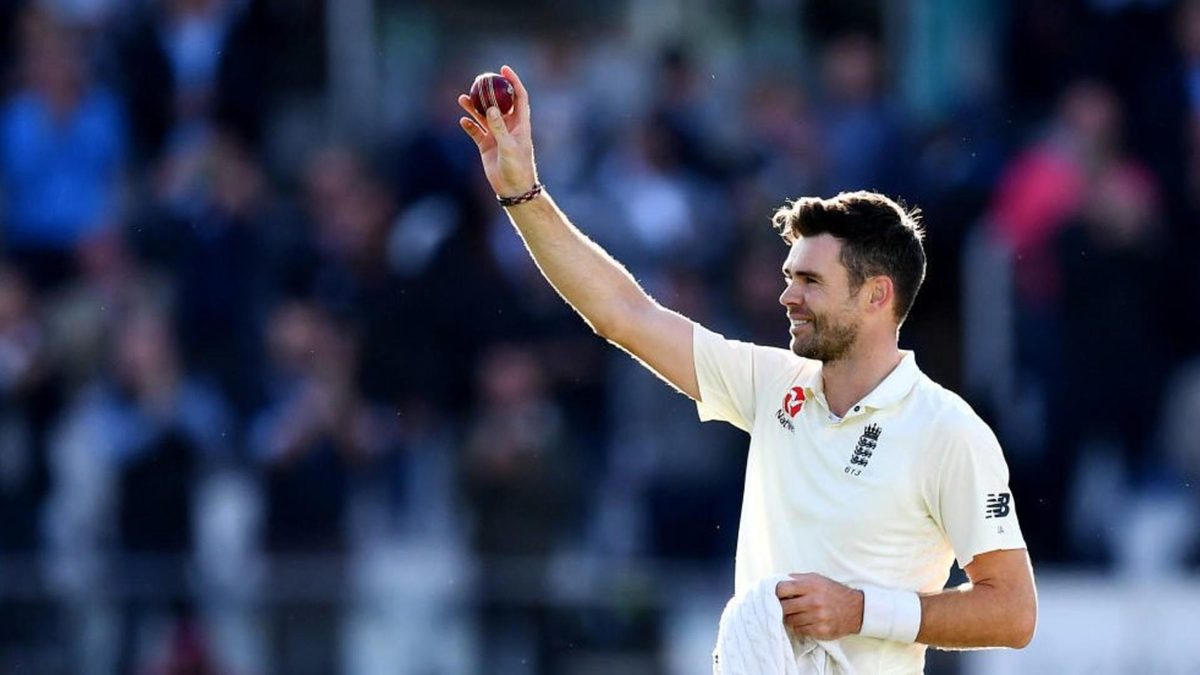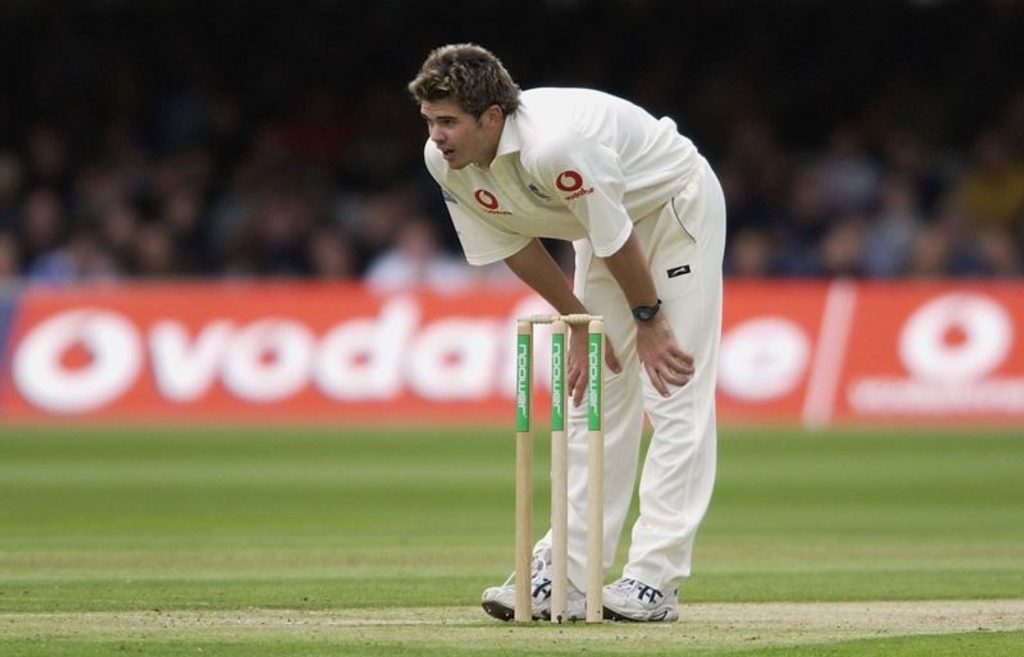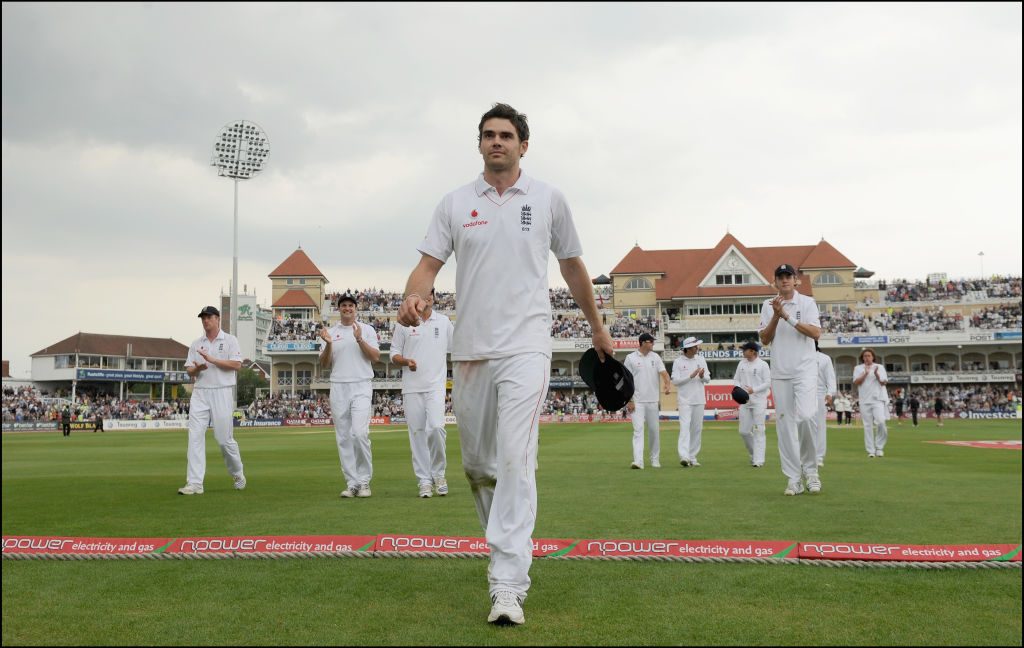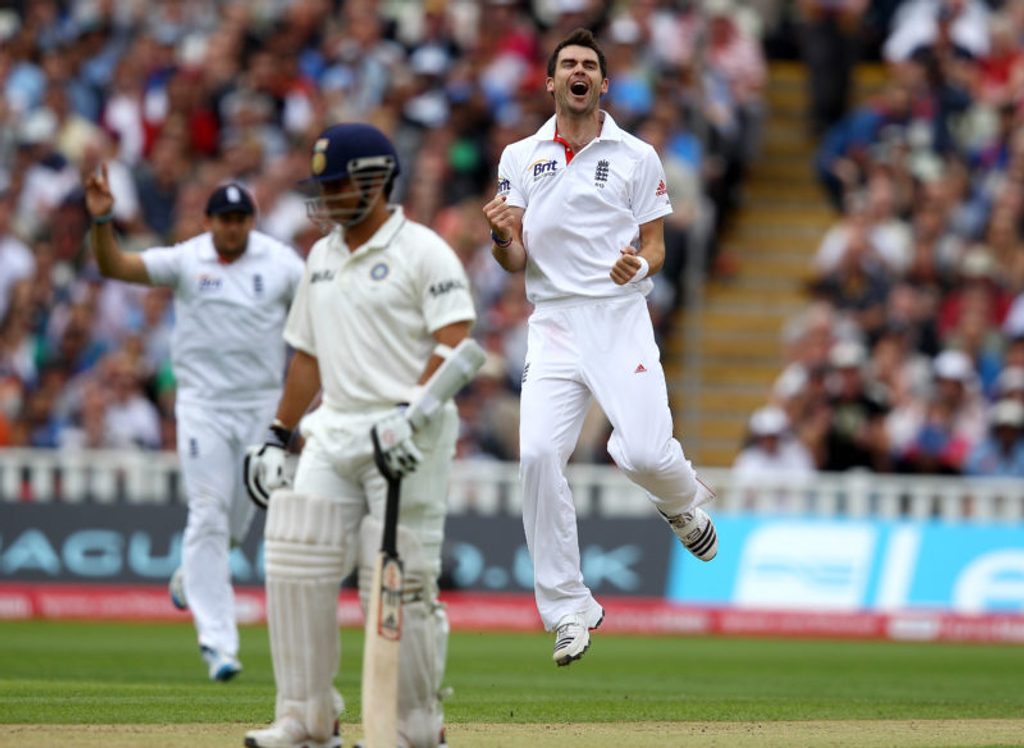
First published in the 2018 edition of the Wisden Cricketers’ Almanack, Andy Zaltzman picks out the very distinct phases of James Anderson’s statistically remarkable career as the England swing master moves well beyond 500 Test wickets.
Kandy, December 2007. Sri Lanka were slowly building their second innings after trailing England by 93, with Sanath Jayasuriya, in his final Test, on 31. James Anderson, 25 years old and in his 20th, more than four and a half years after his first, had bowled three overs for eight. Six balls later, Jayasuriya was on 55, and Anderson had bowled four overs for 32. For only the fourth time in Tests, a batsman had hit six fours in an over – two slapped over extra cover, one slashed through Ian Bell’s fingertips at slip, a square-drive, a pull and a thick edge.
Sri Lanka declared at 442 for eight, with Anderson conceding 128 in 23 overs, for the wicket of Michael Vandort. It was his third mauling in consecutive Tests, after figures of one for 134 at Trent Bridge and four for 182 at The Oval, both against India. In those three games, he had conceded 90 boundaries – one every nine balls. England lost at Kandy, and Anderson was dropped, again.
His previous 13 caps had come in seven different stints, spread over 50 Tests. And he had a bowling average of 39. Among England seamers, only Chris Lewis (52 wickets at 39), Phillip DeFreitas (48 at 42) and Andrew Flintoff (32 at 46) had worse averages after 20 Tests (though Stuart Broad and Ben Stokes have since joined the club). His economy-rate of 3.74 was, at that point, the fourth-worst of anyone who had bowled more than 500 overs. There had been flashes of quality, but the Great Selectorial Scrapheap of English Cricketing Hopes must have been gurgling in anticipation, ready to receive the tattered, abbreviated career of yet another wasted talent.
Donald Trump, watching on admiringly while padding up for his daily blast on the White House bowling machine, thinks to himself: “Truly, we live in an age when the unexpected has become normal”
Lord’s, September 2017. Anderson bowls West Indies opener Kraigg Brathwaite with a fizzing inswinger. It is his 500th Test wicket, and reminiscent of his first – Zimbabwe’s Mark Vermeulen – at the same ground 14 years and more than 28,000 deliveries earlier. He is the first Englishman, the third seamer, and the sixth bowler of any genre to reach the landmark. He goes on to take a career-best seven for 42 in 20 overs of unremitting mastery.
Somewhere in the world, Jayasuriya checks YouTube to confirm the 24-run over did in fact happen, and that the bowler was the same James Anderson. In Downing Street, a disappointed Chancellor of the Exchequer wakes up in the middle of a cheese-addled dream in which, as that Kandy Test ended, he had slapped a £100bn bet on Anderson becoming the first Englishman to 500 Test wickets. Donald Trump, watching on admiringly while padding up for his daily blast on the White House bowling machine, thinks to himself: “Truly, we live in an age when the unexpected has become normal.”
At the end of that game at Lord’s, Anderson had taken his last 100 Test wickets, in 23 matches, at an S. F. Barnesian average of 17, with an economy rate of 2.34. It is a staggering sequence, even in the context of the career he has carved since Kandy (461 wickets at 25 in 114 Tests since 2008, including the 2017-18 Ashes). Admittedly, statistics concerning best 23-Test sequences are seldom the subject of animated conversation in pubs, playgrounds or latenight kebab shops these days. But since 1960 – and assuming a minimum of 30 wickets – only Imran Khan, Richard Hadlee, Malcolm Marshall, Waqar Younis, Shaun Pollock and Muttiah Muralitharan have averaged less over a 23-match span. Even more remarkably, the Cannon-Fodder of Kandy has completed the second-most economical 23-Test sequence since 2005, surpassed only by his old friend, Indian left-arm spinner Ravindra Jadeja.
 Phase 1: a talent misused
Phase 1: a talent misused
Anderson’s Test record tells a tale of transformation, endurance and skill. A numerically ugly duckling has mutated into a beautiful statistical swan – one of the best bowlers of all time in English conditions and, during the first half of this decade, one of the best of his generation anywhere.
His career can be broadly broken into three distinct phases: that largely unsuccessful beginning, up to and including Kandy; two years of marked improvement but continued inconsistency; and an elongated peak, from the 2010 English summer onwards, within which there are three sub-phases, two
In Phase 1 (20 Tests, 62 wickets, average 39, economy-rate 3.74), his promise was undermined by injuries and the tinkering of coaches and selectors. There were moments of unignorable quality that ensured he was never fully discarded – five wickets in his debut innings, against Zimbabwe in 2003; seven in the match in a taut victory over South Africa at Trent Bridge in 2003 (when he became the only man to bowl Jacques Kallis twice in a Test); six in England’s memorable win at Mumbai in 2005-06; five for 42 against India at Lord’s in 2007, including Dravid, Tendulkar and Ganguly. Generally, however, he was a project which showed only intermittent signs of reaching fruition, a luxury who interspersed brilliance with profligacy.
Phase 2 (26 Tests, 94 wickets, average 31, economy-rate 3.24) lasted from the Wellington Test in early 2008, when he replaced Matthew Hoggard and promptly dismissed New Zealand’s top five, to the end of the tour of South Africa in 2009-10. That series was trademark Phase 2 Anderson: crucial interventions and prolonged bouts of ineffectiveness. He was now a fixture in England’s side, but ups mingled with downs. After Wellington, he took one for 153 in 24 overs at Napier. He took seven for 43 against New Zealand at Trent Bridge in 2008, then averaged over 40 in his next nine Tests. An eight-wicket Test at Cape Town in January 2010 preceded none for 111 at Johannesburg. The definitive breakthrough remained elusive.
 Phase 2: Regular, but blowing hot and cold
Phase 2: Regular, but blowing hot and cold
It arrived in Phase 3 (88 Tests, 367 wickets, average 24, economy-rate 2.64), which began in the summer of 2010. Phase 3A (22 Tests, 102 wickets at 23 up to the end of the tour of Sri Lanka in April 2012) saw Anderson finally establish himself as one of the world’s best. He took 23 wickets at 13 at home against Pakistan, then 24 at 26 in the 2010-11 Ashes, dismissing Michael Clarke and Ricky Ponting three times each for a total of 61 runs as England won in Australia for the first time in 24 years.
Phase 3B (24 Tests, 85 wickets at 32 from the start of the 2012 summer to the end of the 2013-14 Ashes disintegration) encompassed a relative decline.
Perhaps, at times, the volume of multi-format cricket hampered Anderson. South Africa largely blunted him in 2012. He was superb in India, then toothless on some flat pitches in New Zealand, in 2012-13. He did put in arguably his most important performance, five wickets in each innings at Trent Bridge in the nerve-shredding First Ashes Test of 2013. But he had no influence on the rematch that winter, as the era of Kevin Pietersen, Matt Prior, Graeme Swann and Jonathan Trott came to a stroppily calamitous, controversial-book generating end.
Phase 3C (42 Tests, 180 wickets at 21) has been the most fruitful of all, in which four years of brilliance, especially at home, have produced numbers to rank with the greats. Fred Trueman’s best 42-Test sequence (in terms of average) brought 194 wickets at 20; Ian Botham’s 211 at 20; Brian Statham’s 162 at 21. Anderson’s current streak is similar, in wickets and average, to the best of Michael Holding, Ray Lindwall and Alan Davidson.
 Phase 3: Dominating Tendulkar and the rest
Phase 3: Dominating Tendulkar and the rest
This remarkable success has been aided by the end of his one-day international career in 2015, reducing his workload and enabling undiluted focus on the lines, lengths and skills required for five-day cricket. There have been striking disappointments even in this most pomp-filled section of his career, notably in helpful conditions at Lord’s against India in 2014, on a wicketless final day at Leeds against West Indies last summer, and in the first innings of the day/night Test at Adelaide over the winter. There were also three quiet Tests in India – his first failure in Asia since he returned identical figures (four for 214) in a two-Test series in India in 2008-09.
The difference between Anderson’s records at home and away has led to suggestions he is not the complete bowler. Overall, his record outside the UK – 58 Tests, 188 wickets at 32, and with only five of his 25 five-wicket hauls – is unspectacular (Dale Steyn, by comparison, has 176 wickets at 24 in 39 Tests outside South Africa). But this conceals the same improvement as his overall statistics, as well as his performances abroad during the first half of this decade.
His first 19 away Tests (in Phases 1 and 2) brought 52 wickets at 43. The next 28, from the 2010-11 Ashes to the end of the Pakistan series in the UAE in late 2015, brought 108 at 27, including 43 at 23 in 12 Tests in Asia. These numbers made him one of the world’s most proficient bowlers away from home. In the five English summers between those series, Anderson took 130 wickets at 26. Home or away, then, there was little difference. Since Christmas 2015, however, when England began their victorious series in South Africa, there has been a divergence – 69 wickets at an astonishing 14 at home, 28 at 35 away. He struggled with form and fitness in South Africa and India, while in Australia a decent series haul camouflaged a lack of matchshaping interventions with the new ball. In the first 30 overs of the first innings of these three series, Anderson took just two for 198 – a significant factor in England’s failures in India and Australia.
In terms of an ability to manipulate the motion of five and a half ounces of stitched leather at high speed, peak-Anderson stands comparison with anyone
As with any cricketer of such longevity, there are quirks and fascinations lurking within the stats, especially in his head-to-head numbers against leading opponents. Anderson enjoyed extraordinary success against Tendulkar, dismissing him a record nine times in 58.2 overs for just 208 runs. By contrast, he has extracted Hashim Amla only twice in 131 overs for 398 runs.
Collectively, Tendulkar, Clarke, Kallis, Kumar Sangakkara, Virender Sehwag, David Warner, Virat Kohli and Kane Williamson have averaged 27 against Anderson. But Amla, Mike Hussey, A. B. de Villiers, Graeme Smith, Steve Smith and Ponting have averaged 76. Yet of his 523 wickets, 310 have been top-five batsmen; only Muralitharan (355 out of 800) and Glen McGrath (325 out of 563) have dismissed more.
Unusually, he has been almost equally effective in all four innings, averaging 28 in the first, 27 in the second (when he has taken 13 of his 25 five-wicket hauls), and 26 in the third and fourth. He also averages 27 against both righthanders and left-handers. And while the figure is 41 against No. 3 batsmen, it drops to 24 against No. 4s, in an era when that position has tended to produce the highest average. His record at Trent Bridge is wonderful, with 60 wickets in nine Tests at 18, and seven five-wicket hauls. At Brisbane, by contrast, four Tests have yielded seven wickets at 75. The Oval has been his least successful English ground: 39 at 33. Where you place Anderson in the pantheon is a matter of preference. In 2013, David Saker, then England’s bowling coach, upset many South Africans by describing Anderson as the “most skilful bowler in the world”, and it’s true that over a prolonged period Steyn had a significantly better record. But in terms of an ability to manipulate the motion of five and a half ounces of stitched leather at high speed, peak-Anderson stands comparison with anyone.
Few bowlers have possessed such capacity to make the ball talk. Early in his career, what the ball said was not always pleasant listening for England supporters. “Please hit me for four” were evidently the words Jayasuriya heard it yelp in Kandy. Yet for all that the West Indian batsmen could decipher it at Lord’s last summer, the ball might as well have been speaking ancient Sumerian.
The course of Anderson’s career has been one of cricket’s most striking upward curves. Of the 42 bowlers who have taken 250 or more Test wickets, only two have had a worse average after 20 Tests – Broad and Zaheer Khan (both 40). Since then, Anderson has averaged 25, a 34% decrease – the only other bowlers in that list to have improved by a greater margin after their first 20 Tests are Hadlee (40%) and Imran (37%).
In a less patient era, Anderson might have been discarded after Kandy. Before central contracts, he might have been worn down by the grind of firstclass cricket, rather than preserved and prepared for the international game.
Instead, the sport has been treated to a decade of a supreme craftsman and competitor, honing and perfecting his art, achieving feats and creating statistics that even the most ardent Lancastrian would not have thought conceivable as Jayasuriya peppered the boundary, and another promising England bowler seemed destined to fall hundreds and hundreds of Test wickets short of 500.
Andy Zaltzman is believed to be the first to achieve the double of being both a stand-up comedian and a scorer-statistician for Test Match Special.
The Wisden Cricketers’ Almanack 2018 is the 155th edition of ‘the bible of cricket’. Order your copy now.
Visit the Long Room for more long reads and features.








